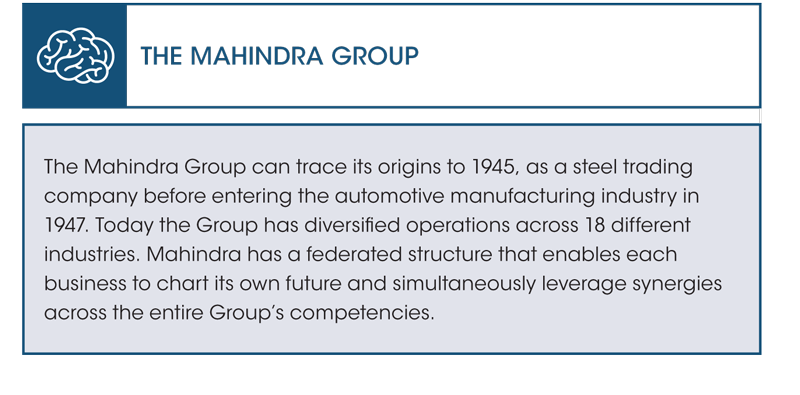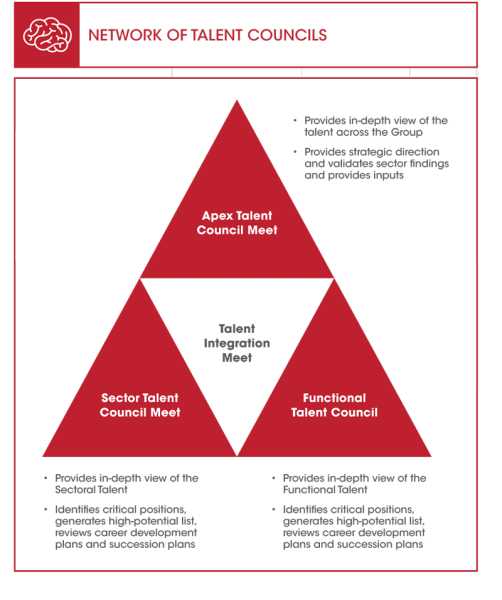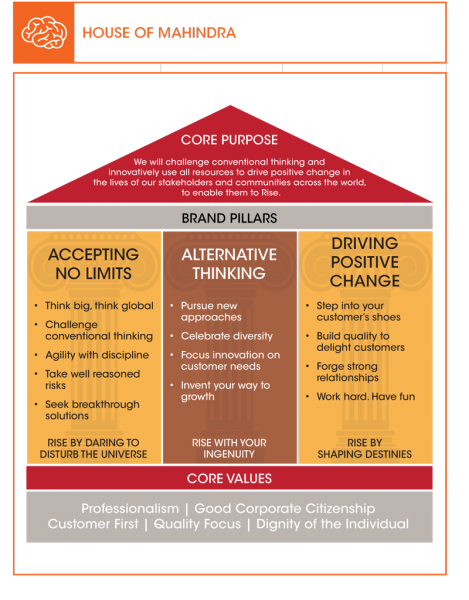Human Resources (HR) is often regarded as a support function of an organisation—rarely invited to sit at the strategic table. But restricting HR to administrative tasks and a cost-saving role is short-sighted, and curtails innovation and delivery of business value. Instead, HR needs to be positioned as a strategic business partner, integral to creating a sustained competitive advantage and an engine for business performance. The Mahindra Group has grown from less than a half billion dollars in annual turnover in the late 1990s and the early 2000s, to current revenues of over US$16.5 billion. Market capitalisation is up 80 times over the last decade. This kind of growth required investing in, and developing, a strong core leadership team.

One of the key initiatives that the Group undertook in 2009 was implementing a massive change management programme, ‘Mahindra Rise’, which became the foundation of its talent and leadership ecosystem. ‘Rise’ seeks to create sustained business outperformance and competitive advantage through a cultural transformation that rests on three attitudes, which we call the ‘Rise Pillars’:

This framework guides all our business and human capital initiatives, and at its heart is the unleashing of human potential through empowerment and driving positive change, both within the organisation and in the larger ecosystem in which we operate. This increases the total factor productivity of our human capital and is a compelling value proposition in creating the Rise culture.
The role of culture
Corporate culture plays a vital part in shaping organisational behaviour. It reflects the firm’s core ethics and values, and is the basis for how employees make both long-term and day-to-day business decisions. Having the right kind of culture is thus critical for ensuring choices and behaviours that reflect the core values of the business, taking into account all stakeholders and contributing to sustained business outperformance. But to shape behaviour and empower productive decisions that are in line with the values and ethical standards of the company, the firm’s culture needs to be organisation-wide and pervasive.
The core values of a firm must therefore be aligned to all HR levers and corporate functions in order to create shared characteristics across the organisation. This includes work design, organisational structure, the recruitment and induction process, performance management system, communication strategies and the talent management system. These values must then become synonymous with the corporate culture and identity, which ultimately affect the everyday behaviour of employees. It is not enough to focus on just one or two parts of the firm’s functions. What is desired is a holistic approach that maximises the chances of creating the intention, attitude and resultant behaviour among employees.
So, for example, if we want to create a culture of innovation where ‘alternative thinking’ is encouraged—but only the annual appraisal lever is aligned to this objective, and other levers like communication, talent management and recruitment are not included—we are unlikely to create such an organisation where alternative thinking is widely practised in everyday behaviour and decision-making. Hence, the entire organisational structure needs to be geared towards innovation across all activities.
This is one of the key reasons why an increasing number of firms are abandoning their old command and control-style bureaucracies, and are instead adopting a more decentralised model. The basic principle is that f latter, decentralised structures are more nimble, responsive and adaptable, which help to create greater cross-functional synergies and innovation. However, it can also make a highly focused strategy more difficult to implement, as the ability to command and direct troops is more challenging when decentralised. This kind of holistic systems approach requires committed and empowering leadership, and the right kind of cohesive culture to keep it all together.
For HR to adopt a holistic leadership role and drive greater cross-functional alignment, it cannot afford to operate in a silo—as it often does—because it will be unable to inculcate the right kind of culture that enables a sustained competitive advantage.
How do leaders influence culture?
There are five leadership qualities that are absolutely critical in enabling leaders to instil and influence the right kind of culture and empower employees: whole brain thinking, multipliers of engagement, innovation, mindfulness and authenticity. Mahindra has several ways to measure and build upon these characteristics. A customised psychometric test, developed for us by SHL (a global leader in talent measurement), assesses these five leadership qualities. But more importantly, we look for anecdotal evidence during the annual 360-degree feedback evaluations. We also communicate to the organisation the value of these characteristics.
WHOLE-BRAIN THINKING
The first critical quality that leaders must have is to seamlessly combine left- and right-brain thinking in any situation. People who do this are good with people, but can also handle numbers. They can think creatively and analytically; they have strong intellectual and emotional quotients. In essence, they use their whole brain.
Whole-brain thinking is developed largely though exposure. Every year at Mahindra, 30 of our senior people go for a week-long retreat at a leading business school. This is a customised programme co-created with faculty that uses business case studies and brings in guest lecturers who exhibit the leadership qualities we are looking to develop. We then bring this back to Mahindra Leadership University, a virtual university with simultaneous online and offline offerings, to further encourage our people to develop whole-brain thinking.
One way we do this is by taking these discussions out of the classroom. For example, we can have a discussion that relates Shakespeare to strategic thinking while listening to live jazz being performed at a dinner function in an art gallery. For those of us who are used to the strait-laced experiences of humdrum corporate life, something like this becomes a whole-brain experience. It helps us to build leaders that are just as comfortable talking about music, literature and art as they are about private equity and financial multiples—and relating it all back to business. It encourages thinking that can pull ideas from any direction.
MULTIPLIERS OF ENGAGEMENT
Second, leaders must be multipliers of engagement, passion and ownership—as opposed to the old command and control style. Rather than giving answers, they need to ask questions, and hence be good listeners, respectful of other people’s ideas. We do not want leaders who think they know best and tell others what to do. When leaders are open to outside opinion and ask questions, they encourage rich conversations that produce different answers and new ideas. This further inculcates leadership, as employees feel more comfortable sharing their ideas and taking ownership.
INNOVATION
The third leadership quality supports innovation. Leaders need to encourage a culture of risk taking and innovation, which involves knowing how to manage the fear of failure—the enemy of innovation. Failure must not be penalised, but instead be used as a learning tool and leveraged to create success.
For example, Mahindra has a business vertical that deals in multi-brand used cars. It was doing poorly, so we tested several new business models, allowing ourselves to make mistakes. Through experimentation and persistence, we were able to develop a successful hybrid ‘click-and-brick’ business. Today Mahindra is using data analytics and algorithms to redefine this industry, which was previously unorganised with very little structured information available.
MINDFULNESS
The fourth quality is mindfulness. Leaders need to have the ability to get deep into the flow, to be fully in the ‘here and now’ and be open to all possibilities for creating value. Thus, when leaders meet someone, they give him or her their undivided attention, signalling that they are listening and engaged.
When mindful, the conversation rises to a more meaningful level. When the leader becomes so engaged, other are drawn in and their focus is increased, which can positively impact overall performance.
AUTHENTICITY
The fifth leadership quality, and the most important, is creating a culture of trust, whereby people trust the leader and the leader, in turn, trusts his or her people. Most important is authenticity and credibility, to ‘walk the talk’, so to speak. If leaders are truthful people, there is no second-guessing their meaning. Authenticity and genuineness must be developed by encouraging leaders to be themselves—with regard to both their strengths and weaknesses. Leaders must not be ashamed to say, “Sorry, I made a mistake and I stand corrected.” This encourages others to open up and speak, which increases the quantity and quality of the dialogue.
Taken together, these qualities are essential for leaders to empower others and create the right kind of innovative culture. But leadership qualities may not necessarily be innate, and in some cases needs to be developed. And just as importantly, employees must also accept empowerment.
So what can HR do to inculcate leadership that fosters the ‘right kind of culture’ that enables sustained competitive advantage?
Building leaders and investing in talent
Surprisingly, a lot of employees find it difficult to accept empowerment—it is, after all, much safer to do as told—but the bigger reason is that they are not used to it. The educational system, particularly in India, does not create the level of skills that we need for recruits to hit the ground running. This is a key factor to keep in mind when recruiting, and there needs to be a strategic view when acquiring talent.
At Mahindra, we are now focusing not only on the skills, but the potential that people bring to the organisation. There is, in fact, a trend in the talent management space to take a closer look at potential versus acquired skill sets. However, this demands a far more rigorous selection and recruitment process, as the evaluation criteria are significantly more nuanced. Our end-goal is to look for future leaders, so we are developing a whole ecosystem that will create skilled talent as well as leadership mindsets. This has resulted in a shift from a transactional, short-term approach of filling organisational needs to putting much more emphasis on long-term human capital development aligned to our business strategy.
We do this through a robust talent management system with HR acting as the process keeper. We try to keep to a 70-20-10 model—70 percent emphasis on learning by doing (for instance, through job assignments with management providing plenty of empowerment to future leaders), 20 percent on coaching and mentoring, and the remaining 10 percent on formal training. This architecture dictates that our business leaders become heavily involved in the talent management process.
This model is not new and most HR practitioners agree with its principles. However, it is rarely executed. Many people in the field still tend to put too much emphasis on formal education, probably because it is easily measured. But experience, coaching and mentoring are far more important. Firms need to recognise the power of the ‘70-20’ opportunities, which are not expensive and beyond reach, but do require focus and dedication. The returns can be significant, provided they are done strategically.
How Mahindra does it
While we want empowered and inspired leaders, we must also recognise that the competency of our leadership team is essential to success. Our approach to developing and maintaining competency is structured along three angles. The first is from the perspective of the organisation itself. We evaluate our long-term business strategies and identify the competencies required to realise company goals and objectives. If we don’t have these competencies now, then how do we create them? The second is to look at our talent pipeline and compare it to our critical positions to ascertain if the pipeline is fit to fill those positions. These first two angles are from the organisational perspective. The third angle is from the individual perspective, where individuals have a personal development action plan designed to meet their own career aspirations within the context of meeting the organisation’s needs as a whole.
The key to our talent management process is its strong link to our performance management system, which is aligned to our leadership ideals embodied by the Mahindra Rise programme. Our talent management process comes to life through a network of Talent Councils, both at the business and function level, overseen by the Apex Talent Council, which is chaired by Anand Mahindra, the Group Chairman. This is critical to our holistic approach.
There are a total of 10 such Councils, including the Apex Council. These councils consist largely of business leaders, with the process being facilitated by HR, to ensure that talent management is aligned to strategic business needs. While the business and functional councils meet regularly throughout the year, the Apex Talent Council spends roughly two weeks every year interacting with, and integrating the activities of, the business and functional councils. The possibility of moving talent across businesses, functions and geographies is an important part of the conversations that take place during these interactions, particularly since cross-sector movement is essential to gaining the experience and exposure necessary to build leadership.

We try to align the career of an individual with his or her aspirations and strengths. This kind of structured talent management approach enables us to create a win-win situation for both the organisation and the individual.
There is an enormous amount of rigour that goes into our talent management process. In the early years, there was scepticism and some resistance from the business leaders who felt that their time could be better utilised attending to business imperatives rather than on human talent. But as they got deeper into the process, they started realising the immense value of this exercise. Today, Mahindra can rightfully claim that this is a vital and integral part of the way we do business and creates competitive advantage in the businesses that we operate in. However, this was not a quick win; it was a gradual mindset shift that took time.
An important development was the creation of the Mahindra Leadership University, which focuses on the development of leadership and domain capability across all levels. The pedagogy is based on our belief in the ‘3Es’ (Experience, Exposure and Education), which of course is an embodiment of the 70-20-10 approach of learning, and helps us create a signature ‘One Mahindra Learning’ experience for our employees.
With the objective of sustaining a rich and robust leadership pipeline, we have built programmes that help us in identifying talent at an early stage, and investing in them to develop tomorrow’s leaders. As an example, at the Group level we have the Mahindra Group Management Cadre (GMC), which is an elite leadership programme aimed at grooming young talent selected from leading business schools. We support these young women and men in realising their potential by providing them with a diversity of experiences to shape their careers, and complementing these experiences with coaching, mentoring and knowledge inputs covering diverse disciplines and multi-cultural settings. We put them in key positions throughout the Group to jumpstart their career and empower them to ‘Rise’ and make a mark in the Group.
At the various business/sector levels we have focused programmes, such as the Early Leaders programme and the Young CEO programme, which identify and develop high-potential employees with the aim of building a leadership pipeline right from the junior management levels. And for senior leaders, we have programmes such as the Mahindra Universe programme (a customised programme at the Harvard Business School), which takes place every year, along with a couple of other well-respected programmes, one of which is run in India by the Ross School of Business.

We must also recognise that the competency of our leadership team is essential to success.
Measuring the returns on human capital
Today we are recognised as having some of the best people processes in the world. Mahindra was recently ranked by Aon Hewitt as among one of the top 10 companies globally for creating leaders.
Our approach is that we will invest in talent at all levels, and not limit it to just senior leaders or high potentials. We have a laddered approach towards development, where relevant interventions are provided at each level of management, starting from junior management to the senior-most leaders. It is our belief that as long as people are with Mahindra, they should be given every opportunity to be productive and innovative, and have exciting career prospects. Our employees need to see that a lot of value is being added to them, and recognise that as long as they are with us, we enable them to give 100 percent of themselves.
I also cannot overstate the importance of investing in the development of good leadership. And hence, although it is exceedingly difficult to measure the short-term return (especially for leadership programmes), it would be a mistake to not make smart investments in such programmes. While in the short-run these programmes are time consuming and often expensive, in the longer-term—say over a 10-year period—it should become clear that they benefit the business. After all, a firm that develops strong leadership qualities will be able to create the ‘right’ kind of culture, and that influences performance to create sustained long-term competitive advantage. For us, this is the ‘Rise Culture’.
But training and leadership development is just one part. I think it is important to use a holistic framework. For HR to be truly successful in enabling a firm’s competitive advantage, all the HR levers must be aligned. And not only do these have to be aligned, but HR leaders must also know how to balance between the short and the long term.
How much of this is science and how much is art, I do not know. But as we have done in the past, we suggest to keep experimenting.
It is important for HR to use a holistic framework to be truly successful in enabling a firm’s competitive advantage.